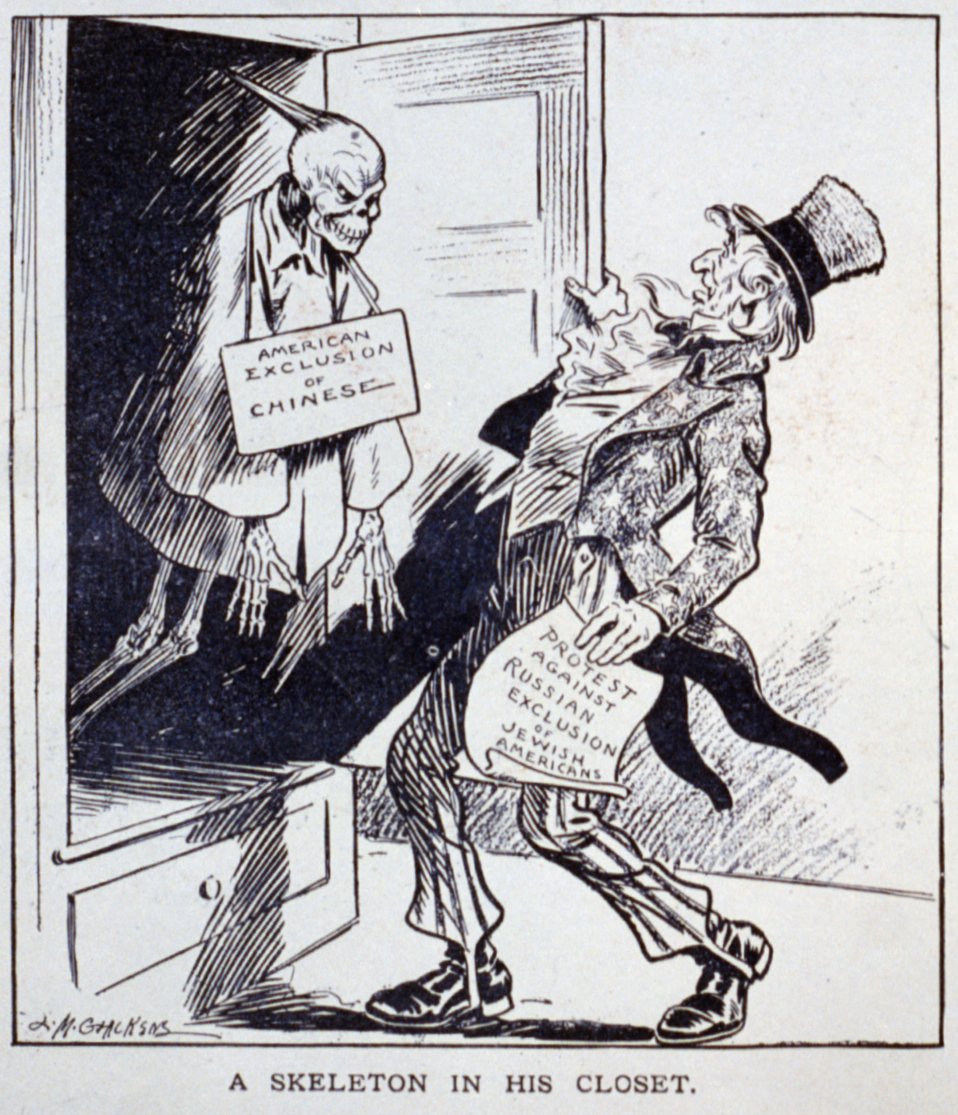Chinese Exclusion
A Californian Wall
As we hear in Look Up, when the San Francisco earthquake struck in 1906, San Francisco’s Chinese community was already struggling to survive. Signed into law by President Chester Arthur in 1882, the Chinese Exclusion Act had prohibited Chinese laborers from immigrating to the United States and becoming American citizens. Only a select few—such as merchants, ministers, students, and travelers—were exempted from these restrictions.
The Chinese Exclusion Act explicitly categorized people by race, nationality, and class. Although Chinese women had already been targeted for exclusion by the 1875 Page Act, but the 1882 Exclusion Act was the first – and only – federal law to bar an entire ethnic group from entering the US.
Yet Chinese immigrants were only a small fraction of the total immigrant population. From 1870 to 1880, Chinese immigrants made up less than five percent of the total number of arrivals to the U.S. So why was the Chinese community the focus of so much hatred? At least part of the answer is distinctly Californian.
Chinese migrants often worked as laundrymen in the US. This 1886 US commercial/political cartoon suggests that with technological advances, there was no longer a need to employ the Chinese. Credit: George Dee Washing Machine Company.
Beginnings: Gaam Saan
Chinese immigrants were among the first to arrive in California in 1849, as news spread of the fortunes that could be found in “Gam Saan” (Gold Mountain). In the next five years, 25,000 Chinese migrants arrived in California. Although the number of Chinese in the US as a whole was tiny, in California the numbers were more significant. By 1860, 1 in 10 California residents was of Chinese origin.
Chinese newcomers became targets of violence and exploitation almost as soon as they stepped foot on American soil. White prospectors in search of gold deposits regularly drove more experienced Chinese miners from their claims, while state lawmakers imposed an onerous foreign miners’ tax. Barred from testifying against white people in court, assaults on the Chinese in California typically went unpunished.
“Measures must be adopted to check this tide of Asiatic immigration, and prevent the exportation by them of the precious metals which they dig up from our soil without charge.” —John Bigler
Miners pose for a photo during the California Gold Rush at Auburn Ravine in 1852. The photo shows both white and Chinese miners
Lynchings and Anti-Coolie Laws
As the gold fields were exhausted, Chinese laborers were recruited to join the American West’s labor force, working in agriculture, mining, industry, and constructing the Transcontinental Railroad. 15,000 Chinese workers helped to build the railway that would open up the American West. Railway barons like Leland Stanford (who founded Stanford University) lobbied for Chinese immigration to continue – largely because these Chinese laborers were paid far less than their white counterparts. In 1868 the Burlingame-Seward treaty between China and the USA committed both countries to uphold “free migration”.
But even before the railway was finished in 1869, anti “Coolie” (a derogatory word for a laborer of Asian descent) clubs started to advocate for a total ban on Chinese immigration. In 1862, California passed an act imposing a tax on both Chinese laborers and their employers. Incensed by claims that the Chinese were taking jobs from white laborers and undercutting wages, vigilantes frequently targeted California’s Chinese. In October 1871, a mob in Los Angeles killed nineteen Chinese immigrants, one of the largest mass lynchings in American history.
California’s politicians helped fuel this nativist anger. In the late 1860s, California's then-governor, Henry Haight, warned that a continuing influx of Chinese immigrants would “inflict a curse upon posterity for all time.” State lawmakers campaigned actually campaigned against ratifying the 14th and 15th Amendments to the US Constitution, fearing they would grant citizenship and voting rights not just to freed slaves in the South, but also to Chinese in the West. Spurred on by anti-Chinese sentiment, California was the only free state to reject both Constitutional measures outright.
Editorial cartoon "A Skeleton in His Closet". Uncle Sam holding paper "Protest against Russian exclusion of Jewish Americans" and looking in shock at Chinese skeleton labeled "American exclusion of Chinese" in closet. Puck, 3 January 1912
“Devastation”: 2 October 1880 by George Frederick Keller, The San Francisco Illustrated Wasp
The Chinese are pagans, serfs, members of an inferior, effeminate and servile race. —Henry Haight, Governor of California, 1867
Political Cartoon 1886: “Uncle Sam kicks out the Chinaman”
The Chinese Must Go!
In the 1870s, with the railways complete, California saw not only huge population growth but also rising unemployment, coupled with financial crisis. All this compounded the pre-existing anti-Chinese movement among California’s white labor unions. Activists blamed Chinese workers for the lack of employment, and accused the Chinese of driving down wages.
San Francisco was at the center of the anti-Chinese movement. A series of laws were passed in the city specifically targeting the city’s Chinese residents: the Sidewalk Ordinance of 1870 prohibited the use of poles to carry merchandise on sidewalks (non-Chinese used wagons and carts); the Cubic Air Ordinance of 1871 required more than 500 feet of living space (San Francisco's Chinatown was severely overcrowded, and hundreds of Chinese were jailed for breaking this ordinance); and the Laundry Ordinances of 1873 and 1876 imposed fees on anyone who carried laundry without a horse-drawn wagon.
Then, in 1877, the Workingmen’s Party of California was founded in 1877 around the rallying cry, “The Chinese Must Go!” The party’s founder – Irish immigrant Dennis Kearney – described the Chinese as “cheap working slaves” who undercut American living standards. He appealed to the federal government for legislative action. In July 1877, a speech by Kearney outside San Francisco city hall led to three days of rioting in the city, with Chinese businesses burnt to the ground and the docks of Steamship companies attacked.
Illustration of a meeting of the Workingmen's Party of California on the sand lots before San Francisco City Hall. Initially published on page 41 in the March 20, 1880 issue of Frank Leslie's Illustrated Newspaper.
Barred
Officially, the 1882 Chinese Exclusion Act barred new Chinese laborers from coming to the United States for 10 years. In theory, laborers who had already entered the US could continue to travel to and from China. Wealthy, professional Chinese — merchants, students, missionaries and their families — were also exempt from the ban. But the long-term intention behind the Act was very clear. America wanted no Chinese. Courts were barred from granting any Chinese resident American citizenship, and the Chinese couldn’t travel back to China without obtaining a re-entry certificate. These were the first “passports” required at the US border — three decades before other Americans would be required to travel with documentation.
Angry at these racist laws, the Chinese community fought back. The Chinese Six Companies — an organization bringing together the leaders of all the family associations to which Chinese migrants belong — joined with the Chinese consulate and raise funds to hire lawyers. When long-term American residents who had visited China were refused entry on their return, the Chinese filed habeas corpus cases, alleging they were being illegally detained on board their ships. Initially, they met with some success, bringing thousands of cases to Federal court, and bringing California’s justice system to a standstill. But Federal judges pleaded for relief, and over the next decade, Congress acted to tighten exclusion. In 1888, the Scott Act abolished re-entry certificates, leaving 20,000 Chinese laborers stranded outside the United States — and a similar number unable to visit wives and family back in China without leaving the US forever.
In 1892, the Geary Act extended the Exclusion Acts for 10 more years, and required all Chinese residents to carry permits or risk expulsion. The Courts continued to offer some protection from the worst excesses of anti-Chinese intent — in the 1898 Wong Kim Ark case the U.S. Supreme Court confirmed that all those born on American soil are U.S. citizens, regardless of ethnicity — in 1902 the Exclusion Acts were made permanent. This was why by 1906 — as we hear in Look Up — San Francisco’s Chinatown was shrinking, with an aging bachelor population, and little prospect for long-term survival.
California must be all American or all Chinese. We are resolved that it shall be American, and are prepared to make it so. —Dennis Kearny, 1877
San Diego poster, 1882
Image credit: Frank Leslie's illustrated newspaper, vol. 54 (1882 April 1), p. 96, Wikimedia commons
A Modern Immigration System
The Chinese Exclusion Act can be seen as the foundation upon which many aspects of modern American immigration policy were built. The Chinese Exclusion Act introduced a precedent for “gatekeeping” citizenship that fundamentally changed the way Americans thought about – and policed – race, immigration and belonging. It also established race, class, nationality as yardsticks by which to measure “desirability" of immigrant groups.
Enforcing the Chinese Exclusion Act also required the creation of an enormous state bureaucracy, capable of screening, registering and tracking Chinese immigrants. Policing Exclusion laid early building blocks for regulatory immigration infrastructure that still exists today: federal immigration agencies, U.S. passports, “green cards,” and deportation practices. This legacy can be seen on a visit to Angel Island Immigration Station in San Francisco Bay, where over three decades nearly half a million immigrants were processed, some of whom were detained for nearly two years. It can also be seen in many of the ways in which the U.S. continues to police its borders today.
In 1943, the US passed legislation allowing an annual quota of 100 Chinese immigrants to enter. But the Chinese Exclusion Act was only fully repealed in 1965, and anti-Asian racism continues. Since 2020, there have been over 10,000 reported acts of anti-Asian violence in the United States.
Protesters
Panoramic view from the US side of the new (2017) border wall between Sunland Park, New Mexico, United States, and Anapra, Chihuahua, Mexico. Credit: Dicklyon, CC by SA 4.
Want to Learn More?
The Chinese-American Experience: An Introduction, William Wei
The bloody history of anti-Asian violence in the West, National Geographic
The Forgotten History of the Western Klan, The Atlantic
Chinese Exclusion Act, 1882, Library of Congress
At American Gates: Chinese Immigration During the Exclusion Era, 1882-1943, Erika Lee
The Chinese Must Go: Violence, Exclusion, and the Making of the Alien in America, Beth Lew-Williams









